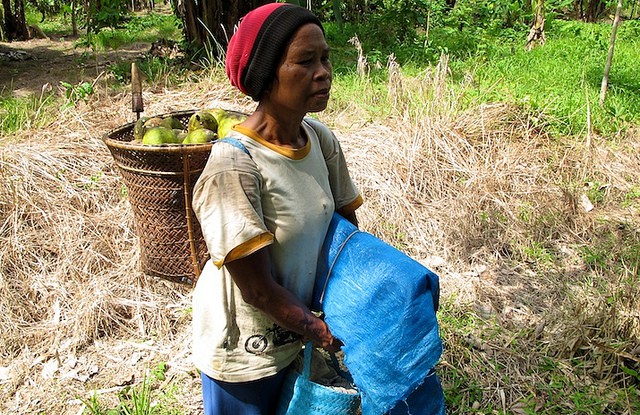
Editor’s Note: This article was previously published on the website of the World Congress on Agroforestry. In honor of International Women’s Day, Forests News is re-publishing it here.
In the forest communities of Africa, a division of labor has long been clear among men and women. Women have typically been in charge of feeding the family through food-crop cultivation, with their diet supplemented by non-timber forest product (NTFP) collection, while the men helped to clear the food crop plots and concentrated more on cash-crop cultivation and hunting.
Historically, NTFP gathering and food crop cultivation were mainly for domestic use. But those days are gone — the opening of remote areas, better access to urban markets, and new opportunities of income have motivated women and men in forest communities to be actively involved in the sale of NTFPs and agricultural products in order to make more money.
“Unlike in the past, one can say things are improving for the best for the rural woman,” said Kira Tongo Boniface, a Bantou man from Petit-Pol village in eastern Cameroon, during a gender-segregated focus group discussion (FGD) in his community. He claims there are numerous activities — agriculture and NTFP gathering among them — that rural women are involved in that provide them with daily income to sustain their families. But is this really the case?
Interestingly, information obtained through gender-segregated FGDs showed that men and women have similar access to NTFPs in the wild, with restrictions occurring only on plots of land under cultivation or in fallow, where in general the landowner and his or her close relatives have exclusive access to these products. However, the men and women who participated in the discussions expressed having different preferences for forest products.
The women take more interest in NTFPs such as bush mango, for which they are the primary gatherers, processors and sellers. Fewer men are involved in this activity; some who are say they do it to raise income when they are in dire need for money, while others do it as a form of assistance to their wives when they have no other activities to do. Men are much more actively involved in other forest-related activities such as bushmeat hunting and small-scale logging.
Nowadays, NTFPs are more valued because the revenue they provide is becoming increasingly important to rural communities. But then, some hindrances are on the rise, including the seasonal nature and unpredictable productivity of NTFPs; lack of experience by traders; limited access to processing technologies; poor marketing strategies; and inadequate market information. This weighs on the amount of income realised from NTFP sales.
“Though NTFP gathering and sale are important and profitable to some extent, we cannot rely solely on them for our survival,” said Ndimba, a Bulu woman from Metylkpwale village in southern Cameroon. “We can’t eat only NTFPs every day; we need to diversify our diet, [and] we need money when NTFPs are not producing. Money from NTFP sales is not enough to provide income for the family throughout the year. … As a result, we expanded our agricultural activities (more plots of farmlands were open, more crops were planted), which is now the principal activity – primarily for subsistence and secondly as a means to raise income for the household,” she said.
Because of the increasing cash flow from NTFP gathering and food crop cultivation and sale, men are becoming increasingly interested in these “women’s businesses.”
Menguele Jean, a Bulu man from Ngon village, southern Cameroon, said, “Cocoa produces just once a year, and before production we need money for farm maintenance and also for family upkeep. We therefore decided to open larger plots in order to produce more food crops too for sale.”
This new drive for income over time has led to more labor for the women, who are expected to cultivate larger plots while maintaining their demanding daily house chores.
During an FGD in Melambo village in eastern Cameroon, one woman complained that she worked more yet earned less than she thought she would: “We the women, who do most of the labor, get to remain retailers of NTFPs and food crops with very little profit, but the men … have become more of wholesalers and are enjoying most of the profit without labouring as much as we do.”
As NTFPs become more important as sources of income, it appears that the respective share from the sale of NTFPs and agricultural products between men and women needs to be renegotiated.
Yvonne Kiki Nchanji is a consultant at CIFOR and Fellow in Bioversity International’s Gender Research Fellowship Programme. She is based in Yaoundé, Cameroon.
This research forms part of the CGIAR Research Program on Forests, Trees and Agroforestry.
We want you to share Forests News content, which is licensed under Creative Commons Attribution-NonCommercial-ShareAlike 4.0 International (CC BY-NC-SA 4.0). This means you are free to redistribute our material for non-commercial purposes. All we ask is that you give Forests News appropriate credit and link to the original Forests News content, indicate if changes were made, and distribute your contributions under the same Creative Commons license. You must notify Forests News if you repost, reprint or reuse our materials by contacting forestsnews@cifor-icraf.org.

